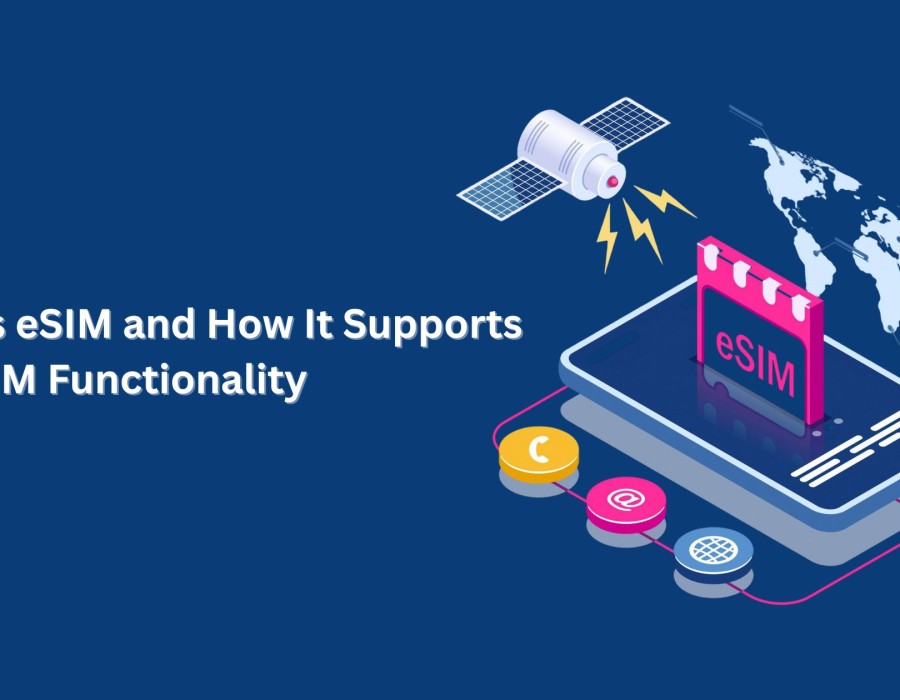Mobile technology has changed tremendously by the evolution of mobile technology. E-SIM technology represents a paradigm shift to that of mobile SIM cards. EMBEDDED> Unlike ordinary physical SIM cards, eSIM technology has been made to assist in flexibility, improve hardware design and enhance user satisfaction. What eSIM basically is, its working mechanism, and how it fits into the dual SIM functionality are what we will focus on in this article.
Understanding eSIM Technology
The eSIM provides digital version capabilities through its embedded SIM feature. Your device includes the eSIM as an integral part of its hardware instead of providing it as an external component. Users benefit from an integrated approach which enables network and plan switching while requiring them to avoid physical SIM card exchanges. For those wondering, what is eSIM, it’s essentially the next step in mobile technology designed for seamless connectivity.
The GSM Association (GSMA) develops standards for eSIM technology which makes the solution work with all devices and networks throughout the world. Users can download mobile network profiles through over-the-air (OTA) activation because of eSIM technology which streamlines mobile network addition and switching.
Key Features of eSIM:
- Non-removable Design: The eSIM chip is embedded into the device, eliminating the need for SIM card slots.
- Remote Provisioning: Users can activate their mobile plans digitally by scanning a QR code or using a carrier app.
- Multiple Profiles: An eSIM can store multiple carrier profiles, allowing users to switch between them as needed.
- Enhanced Security: Embedded chips are less susceptible to theft or tampering compared to physical SIM cards.
How eSIM Works
eSIM technology uses a secure, programmable chip within a device. Here’s how it functions:
- Carrier Profile Installation: Users receive a QR code or a carrier-provided activation code. Scanning the code downloads the carrier’s profile onto the eSIM chip.
- Network Selection: Once the profile is installed, the user can select their preferred network through the device’s settings.
- Switching Profiles: If multiple profiles are stored, users can seamlessly switch between them without needing a physical card.
- OTA Updates: Network profiles and configurations can be updated remotely, offering convenience for both users and carriers.
Dual SIM Functionality with eSIM
The efficiency of eSIM technology cannot be undermined as it provides for double SIM functionalities. In the ordinary, the double SIM cards are placed in two physical slots. The users, however, may use the eSIM and one physical SIM card to get dual SIM benefits, or even two eSIM profiles in those devices which support it.
How Dual SIM Works with eSIM:
- Primary and Secondary SIMs: A device with eSIM can have one profile set as the primary number for calls, texts, and data, while another profile can serve secondary purposes.
- Seamless Switching: Users can toggle between SIM profiles directly from their phone’s settings, making it easy to manage personal and business numbers on the same device.
- Concurrent Use: Many devices allow both SIMs to remain active simultaneously, enabling users to receive calls or texts from either number without manual switching.
Benefits of Dual SIM with eSIM:
- Flexibility: Use one SIM for personal use and another for work without carrying two devices.
- Travel Convenience: Activate a local network’s eSIM profile when abroad while retaining your home network on the physical SIM.
- Cost Efficiency: Select different carriers for voice and data to optimize costs.
Advantages of eSIM Technology
eSIM technology has several advantages over traditional SIM cards:
- Space-Saving Design: By eliminating the need for a SIM card slot, manufacturers can use the space for other components, such as larger batteries or improved cameras.
- Enhanced Durability: Without a removable SIM tray, devices are better sealed against water and dust.
- Simplified Connectivity: Setting up a new carrier plan is faster and easier with eSIM.
- Global Compatibility: Travelers can quickly switch to local carriers without needing a physical SIM card.
- Environmental Benefits: Reducing the production and disposal of physical SIM cards contributes to sustainability.
Challenges and Limitations of eSIM
While eSIM technology offers numerous benefits, it also has some limitations:
- Carrier Support: Not all carriers support eSIM, limiting its availability in some regions.
- Device Compatibility: Only newer devices support eSIM technology, which may exclude older models.
- Limited Profiles: Although eSIM can store multiple profiles, there are restrictions on the number that can be active simultaneously.
- User Familiarity: Some users may find the setup process unfamiliar compared to simply inserting a physical SIM card.
Devices Supporting eSIM
Many modern smartphones, tablets, and wearables now support eSIM technology. Some popular examples include:
- Smartphones: Apple iPhones (XS and newer), Google Pixel devices, Samsung Galaxy models.
- Tablets: iPad Pro, iPad Air, and some Android tablets.
- Wearables: Smartwatches like the Apple Watch and Samsung Galaxy Watch.
Future of eSIM and Dual SIM Technology
The speed of eSIM adoption will grow at a fast pace because of technological progress. The integration of eSIM technology into a broad product selection by manufacturers will continue as they bring it to IoT devices as well as laptops and smart appliances. Worldwide user access to connectivity will improve because of this predicted growth.
People benefit from maximum flexibility in dual SIM operation because of eSIM technology. The ability to store multiple profiles and easily transition between them matches the requirements of current users especially business professionals and regular travelers.
Conclusion
The eSIM technological advancement in mobile connectivity brings together three major benefits which are ease of use with adaptable features and flexible capabilities. The device serves users well because it provides dual SIM capabilities which grants users flexible communication possibilities. The future of mobile technology will standardize eSIM technology due to its increasing acceptance among carriers and device manufacturers.





Comments